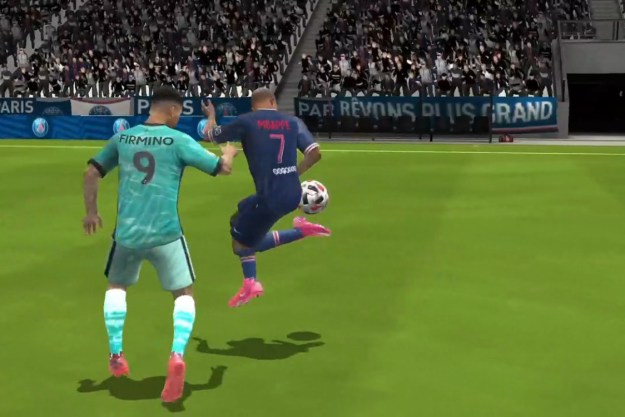I’m standing outside the Olive 8 Hotel in downtown Seattle. The last few minutes of daylight are fading as the attendees of PAX West spill out of the convention center and onto the streets. An old LeSabre station wagon pulls up beside me; its wood panel looks like it came fresh from the Griswold family’s latest vacation. The car is headed out of town on a drive toward the forests of western Washington … and it’s there to take me with it.
The driver beckons me to come join them in the front passenger seat. Normally it’s my policy not to get in a car with strangers and drive off to the woods in the middle of the night, but this was a special case. I’d been offered a unique opportunity: to go hands-on with the tense and eerie upcoming roguelite Pacific Drive, then see the real car and forests that inspired it in a nighttime road trip with some of the development team.
It was an offer I couldn’t refuse, and what followed was a pair of parallel rides through the Pacific Northwest, one real and one digital. I’d go on a memorable adventure involving a bird in a top hat, creepy mannequins, and at least one story of police throwing the development team out of town.
I slide into the passenger seat and snap my seatbelt into place. The growl of the engine announces our departure. We set a course away from the fading sun, towards the same creeping darkness that defines Pacific Drive.
The open road
We are on Interstate 90 in a 1989 Buick LeSabre, heading east towards the forest-covered Cascade mountains. Alex Dracott, Studio Head and Creative Director at Ironwood Studios is behind the wheel as Seattle shrinks in the rearview mirror. Larry Vargas, lead Environment Artist, and Game Designer Richard Weschler are sitting in the back.
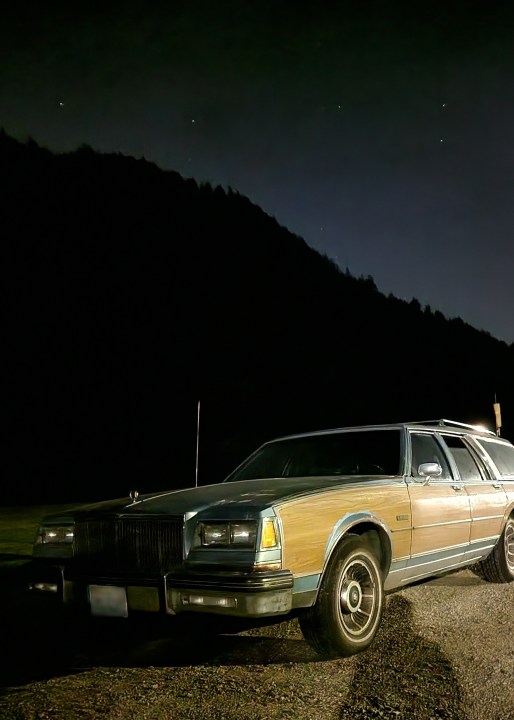
The car is a spectacular ride. It’s a 16-foot long, one-and-a-half ton wood-paneled beauty. The rust along the bumper is a small price to pay for the rich, musty aroma of a well-loved, almost 40-year-old car. The dashboard is a glorious collection of knobs, switches, and an occasionally glowing-red oil warning light whose illumination corresponds more closely to the car’s bumps and jostles than it does to any of the inner workings of the engine. The five-digit odometer has turned over at least once, and the speedometer isn’t particularly interested in letting us know how fast we are going. It’s glorious; this car has enough character to put most video game protagonists to shame.
I ask Alex how he came by the car.
“I wouldn’t call it an impulse buy, but it was an emotional purchase. I saw it, and was like ‘Oh, this is crazy’,” Alex says. “And it lasted without breaking down till the minute I pulled into my parking space at my apartment.”
In the zone
It’s Saturday morning, and I’m at the Pacific Drive booth for some hands-on time with the game. The demo starts at a gas station in the Olympic Exclusion Zone, a part of post-apocalyptic western Washington that’s been separated from the rest of the world by massive, 300-meter-tall walls. I’m next to an old station wagon, and it is in a sad state; out of fuel, missing a wheel, and desperately in need of repairs to the body and windows. I set out to make things right, attaching a found wheel and topping off the tank. Liberal application of a blowtorch heals the car, as cracks and dents fade like Christine, the titular self-healing murder car from the Stephen King novel.
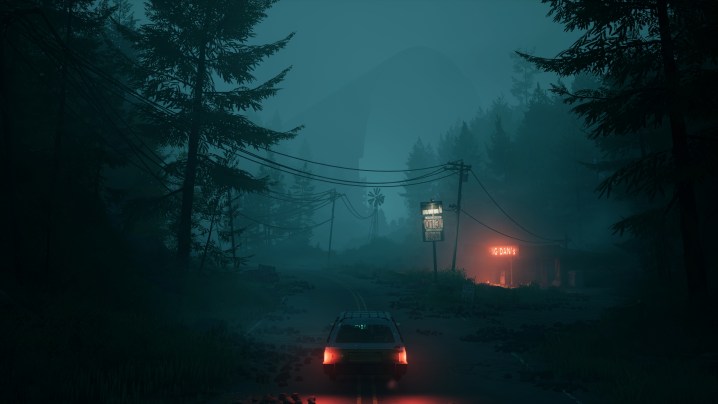
Road-ready, I open the driver’s door and sit down. I give the keys a twist; it takes a second but the engine eventually turns over. The dashboard is adorned with a small blue bird figure, smartly dressed in a top hat (his name is Malcolm, they tell me). I can’t resist the urge to give him a friendly flick.
I shift the car into drive and instinctively look both ways as I pull to the edge of the parking area. There’s no one. I press the gas and hit the open road.
Car talk
Everyone, Alex says, has a car story. Whether it was Richard’s 95 Mercury Tracer with the ceiling fabric that kept falling down, Larry’s 80’s-tacular Acura Integra with the pop-up headlights, or my own 1990 Toyota Corolla that I bought for $300 because that was the price to get it out of impound after it was abandoned, stolen, then abandoned again. We all had cars and times in them we could recall like misadventures with old friends. That idea is a big part of why that car/driver relationship is front and center in Pacific Drive.
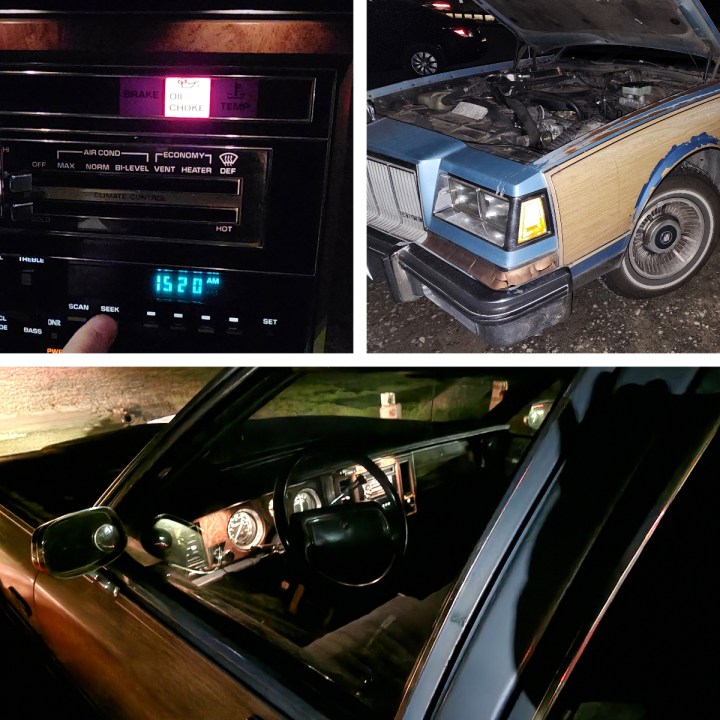
A lot of a car’s personality comes from the quirks that develop over time and that’s also true here, as your in-game car can start to exhibit strange behaviors. Maybe the headlights turn on every time you close the driver’s door, or the radio only works when you drive at high speed. A “shockingly large number” of these came from real-life examples provided by the team and people they know.
As we drive, I learn the LeSabre is more than just inspiration; it served as the source for many of the sound effects used in the game. They strapped an omnidirectional mic inside, and used boom mics under the engine, near the muffler, and by the wheel well to capture audio, which led to another story in the legend of Alex’s Buick LeSabre: The time they were run out of town by law enforcement.
“When we were done we went into town and we were turning heads left and right. We ended up getting stopped by the police. They say we were drawing too much attention and [they] ended up escorting us out of town.”
Lingering dread
My digital car’s engine gives its low, gravelly roar as I drive along the abandoned highway. The steady beat of the pistons is the only company I have as I begin my search. I’m looking for something called an anchor, these balls of energy that feed into something called the Arc Device, allowing me to pass through a portal of some sort and back to safety. There’s a timer counting down before a powerful storm comes to tear me apart.
It’s dark, save for the illumination from my dashboard and the headlights shining ahead. The center of the console houses a monitor with a head-up display of the car, more boxy electronics take up space in the passenger seat. The packed-to-the-brim tech gives the car an Ecto-1 from Ghostbusters feel. One screen displays a map with anchor locations. I consider the possible routes for a moment. I’d like to plan a detailed route, but the ticking clock is giving me anxiety, so I decide to aim for the nearest one, just around a bend to the left.
I follow the road around some uneventful bends and pull up near the marked spot. I hop out of the car and immediately recoil when I see a person standing in the road, staring directly at me. Wait, no, it’s not a person. It’s a mannequin, several in fact. That fact doesn’t make them any less unsettling, especially with the way the chest on each has a pulsing red glow.

I stare at the figures for a while, but they are inert. Cautiously I turn to focus on collecting the Anchor, though I keep glancing behind me. I don’t think they are getting closer, but are there more of them than before? I can’t tell, and that makes me uncomfortable. I reach the Anchor and pull it from its mechanical docking station. I immediately turn and run for the car, giving a wide berth to the cluster of mannequins. I put it in gear, cast one last nervous glance in the mirrors, and speed for the next anchor.
The art of eeriness
They’re called called “Tourists,” Alex tells me.
We are sitting in a booth at the Tipsy Cow, a local burger joint. Jacob Stone, Foreground Art Lead, has joined us. I sip on my beer, a Scotch Ale from a local brewery, as I try to make sense of those damn mannequins. The human silhouette, the glow cutting through the darkness, the way they are slightly melted into the ground, Alex says it all means something, but he won’t spill the secrets today. I’m told I’ll have to play to uncover it, and even then there are no clear answers promised.
I ask about where they drew inspiration for these unsettling elements, and while things like Twin Peaks, The X-Files, and the S.T.A.L.K.E.R. games come up, the mention of Swedish artist Simon Stålengahs stands out. His neo-futuristic art combines the open Swedish countryside with an almost H.G. Wells’ War of the Worlds style of technology and elicits a nervous curiosity that feels very familiar to what I felt playing the game.
This idea of ineffable tech grafted onto something familiar is especially visible in the car itself. The design has a sort of Doc Brown meets Storm Chaser look; things are purpose-built and focus on function over form, and that’s meant to increase over time. Jacob adds that there are no traditional weapons in the game; this isn’t an environment you fight. Instead, you adapt, using tools like the scrapper. If Freddy Krueger had an angle grinder, it would look like the scrapper. A beefy power tool with spinning metal blades, this is one of the primary methods for salvaging, reducing parts you come across to scraps used for repairs and especially upgrades.
“The further you go, the more advanced your car needs to be in order to survive,” Larry tells me.
Chaos ensues
The next stretch of my virtual road trip is littered with the Tourists. I do my best to swerve around them, but I make contact with a few, and I can see my front bumper take damage. I clear the cluster of mannequins and accelerate to the open road ahead. Suddenly a pillar of asphalt and dirt erupts from the ground, a cylinder of earth as wide as the car and twice as tall. I spin the wheel as another pops out of the ground, then another. I serpentine through, but can’t avoid taking a few hits in the process.
Finally, I approach my destination. I park as near the anchor as I can. I hear a buzzing sound as I hop out of the car, and I look around for Tourists or any other anomalies. The coast is clear. I start walking towards the anchor, but something about that buzzing sound doesn’t seem right.
I grab the anchor and start back towards the car when I see the source of the buzz: I’m parked right next to a downed electrical tower and its arcing energy is draining the vehicle’s health. Panicked, I jump back in the driver’s seat, but I rush turning the key, and fail to start the car several times. Clearly, I would never survive in a horror movie. By the time I move it far enough away, the car is in rough shape, I’ll need to be extremely careful if it’s going to survive the rest of my run.
Trail’s end
We pull up to a trailhead outside of town. It’s dark, save for the intermittent illumination of passing cars. The trees form a pitch-black backdrop; the stars and clear skies outline the top of a hill. As we chat around the car, two lights in the distant woods catch our attention. Everyone is silent for a moment. It’s two hikers returning from the trail, perfectly normal given where we are, but that innate response to the unexpected change has the hairs standing on the back of my neck. The instinctual trepidation of the dark woods is inescapable.
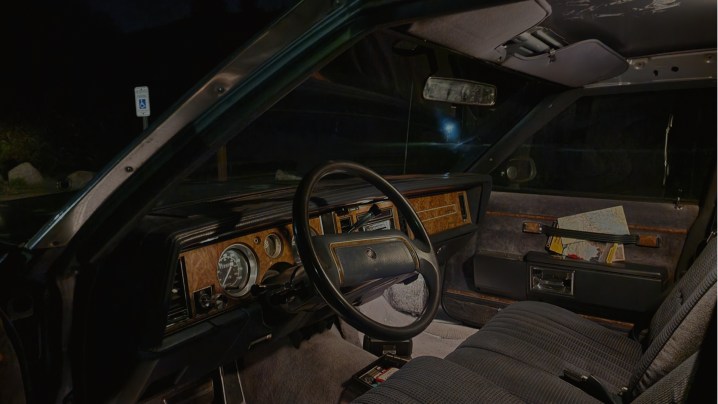
It’s the same discomfort — almost dread — the anomalies gave me while I played, and that’s no accident. Things that are unsettling in real life have the same effect in-game, whether it’s sudden inclement weather that has you gripping the wheel so hard your knuckles turn white, finding an abandoned cabin in the woods, or the radio cutting in and out while you drive alone through the night.
I ask what makes something like the first so creepy. Alex ascribes a lot of that to what we can and can’t see: “If you can see where everything is at all times, then you’re more comfortable.” He mentions visibility and lighting and the ways they tap into it in-game. Effects like fog or limited sight lines while you are in the car are taken into account, making it hard to know exactly what’s outside of the safe space that is the car’s interior.
“The fact that there actually are things out there, that’s just icing on the cake.”
Do or die
I’m running out of time to make my escape.
There are a few Anchors on my map, but they are all a good distance from the road. I pull up as close as I can to one, and I’ve got to make a choice: go the rest of the distance on foot, or take my car off-road. After the incident with the electricity, I decide the car is in no position for me to risk hitting any trees or rocks. I do my best to memorize the location marked on the car’s map and jump out to begin my search.

I have a little over a minute before the timer reaches zero. I’m going as fast as I can toward where I think the anchor is located, but I’m already feeling doubt. I reach the crest of a hill and stop suddenly. There’s some sort of flying ‘machine’ I learn is called an Abductor, and it’s patrolling right near the Anchor. I hide behind a rock, but the clock is running out. I hold for a bit longer, and the Abductor moves further away. I grab the anchor just as time expires, the storm has arrived.
Without the protection of my car, the storm begins aggressively draining my health. It’s a race against time to make it back and escape through the portal before my life runs out. I’ve thrown all caution to the wind, I’m running as fast as I can, consuming healing items all the while to stay alive. I reach the car, and just as the prompt to open the door appears, the last of my health dissipates.
I’m dead. My run has ended. I think about everything that transpired, and I see the mistakes I made. A plan is forming in my head. Confident that the next time will be different, I want nothing more than to turn those keys and start my next drive.
Pacific Drive releases in early 2024 on PlayStation 5, Steam, and Epic Game Store.
Editors' Recommendations
- Baldur’s Gate 3 dev dishes on mods, upcoming epilogues, and Xbox Series S struggles
- Lamborghini is putting race cars in your living room. Hop in and drive one

